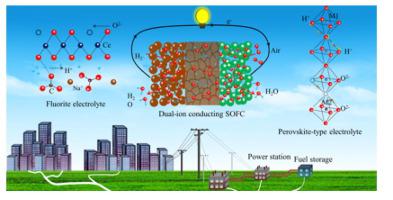Journal of Energy Chemistry ( IF 14.0 ) Pub Date : 2020-09-11 , DOI: 10.1016/j.jechem.2020.09.010 Jiafeng Cao , Chao Su , Yuexia Ji , Guangming Yang , Zongping Shao

|
High-temperature solid-state electrolyte is a key component of several important electrochemical devices, such as oxygen sensors for automobile exhaust control, solid oxide fuel cells (SOFCs) for power generation, and solid oxide electrolysis cells for H2 production from water electrolysis or CO2 electrochemical reduction to value-added chemicals. In particular, internal diffusion of protons or oxygen ions is a fundamental and crucial issue in the research of SOFCs, hypothetically based on either oxygen-ion-conducting electrolytes or proton-conducting electrolytes. Up to now, some electrolyte materials based on fluorite or perovskite structure were found to show certain degree of dual-ion transportation capability, while in available electrolyte database, particularly in the field of SOFCs, such dual-ion conductivity was seriously overlooked. Actually, few concerns arising to the simultaneous proton and oxygen-ion conductivities in electrolyte of SOFCs inevitably induce various inadequate and confusing results in literature. Understanding dual-ion transportation behavior in electrolyte is indisputably of great importance to explain some unusual fuel cell performance as reported in literature and enrich the knowledge of solid state ionics. On the other hand, exploration of novel dual-ion conducting electrolytes will benefit the development of SOFCs. In this review, we provide a comprehensive summary of the understanding of dual-ion transportation in solid electrolyte and recent advances of dual-ion conducting SOFCs. The oxygen ion and proton conduction mechanisms at elevated temperature inside oxide-based electrolyte materials are first introduced, and then (mixed) oxygen ion and proton conduction behaviors of fluorite and perovskite-type oxides are discussed. Following on, recent advances in the development of dual-ion conducting SOFCs based on fluorite and perovskite-type single-phase or composite electrolytes, are reviewed. Finally, the challenges in the development of dual-ion conducting SOFCs are discussed and future prospects are proposed.
中文翻译:

萤石和钙钛矿基双离子导电固体氧化物燃料电池的最新进展和前景
高温固态电解质是几种重要的电化学装置的关键组成部分,例如用于汽车尾气控制的氧气传感器,用于发电的固体氧化物燃料电池(SOFC)和用于通过水电解法生产H 2的固体氧化物电解池。一氧化碳2电化学还原为增值化学品。尤其是,质子或氧离子的内部扩散是SOFC研究中的一个基本且至关重要的问题,假设它们是基于传导氧离子的电解质或传导质子的电解质。迄今为止,已经发现一些基于萤石或钙钛矿结构的电解质材料具有一定程度的双离子迁移能力,而在现有的电解质数据库中,特别是在SOFC领域,这种双离子电导率却被严重忽视。实际上,很少有人对SOFC电解质中质子和氧离子的同时电导率产生担忧,这不可避免地引起了文献中各种不足和令人困惑的结果。毫无疑问,了解电解质中的双离子传输行为对于解释文献中报道的某些异常的燃料电池性能以及丰富固态离子的知识至关重要。另一方面,新型双离子导电电解质的探索将有利于SOFC的发展。在这篇综述中,我们提供了对固体电解质中双离子传输的理解以及双离子导电SOFC的最新进展的全面总结。首先介绍了氧化物基电解质材料内部高温下的氧离子和质子传导机理,然后讨论了萤石和钙钛矿型氧化物的(混合)氧离子和质子传导行为。接下来,综述了基于萤石和钙钛矿型单相或复合电解质的双离子导电SOFC的最新研究进展。最后,讨论了双离子导电SOFC的发展中的挑战,并提出了未来的前景。









































 京公网安备 11010802027423号
京公网安备 11010802027423号